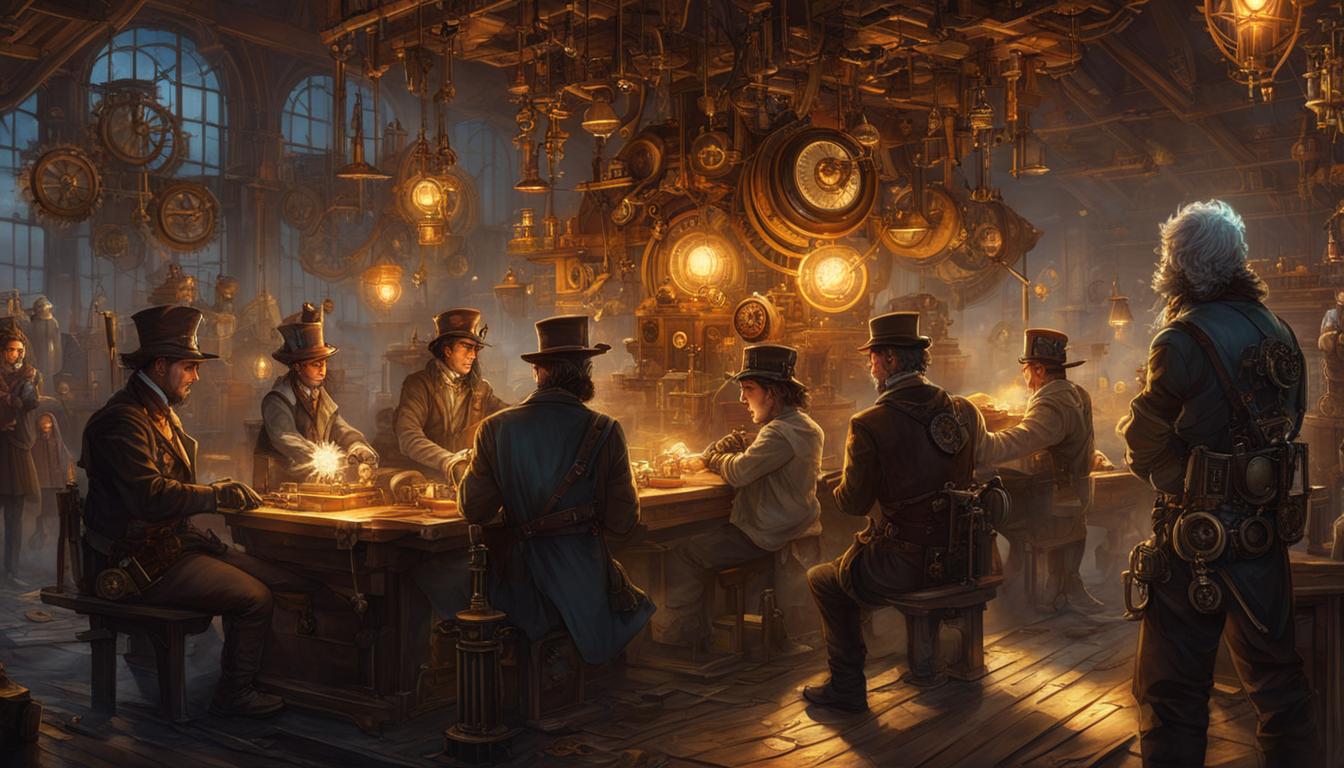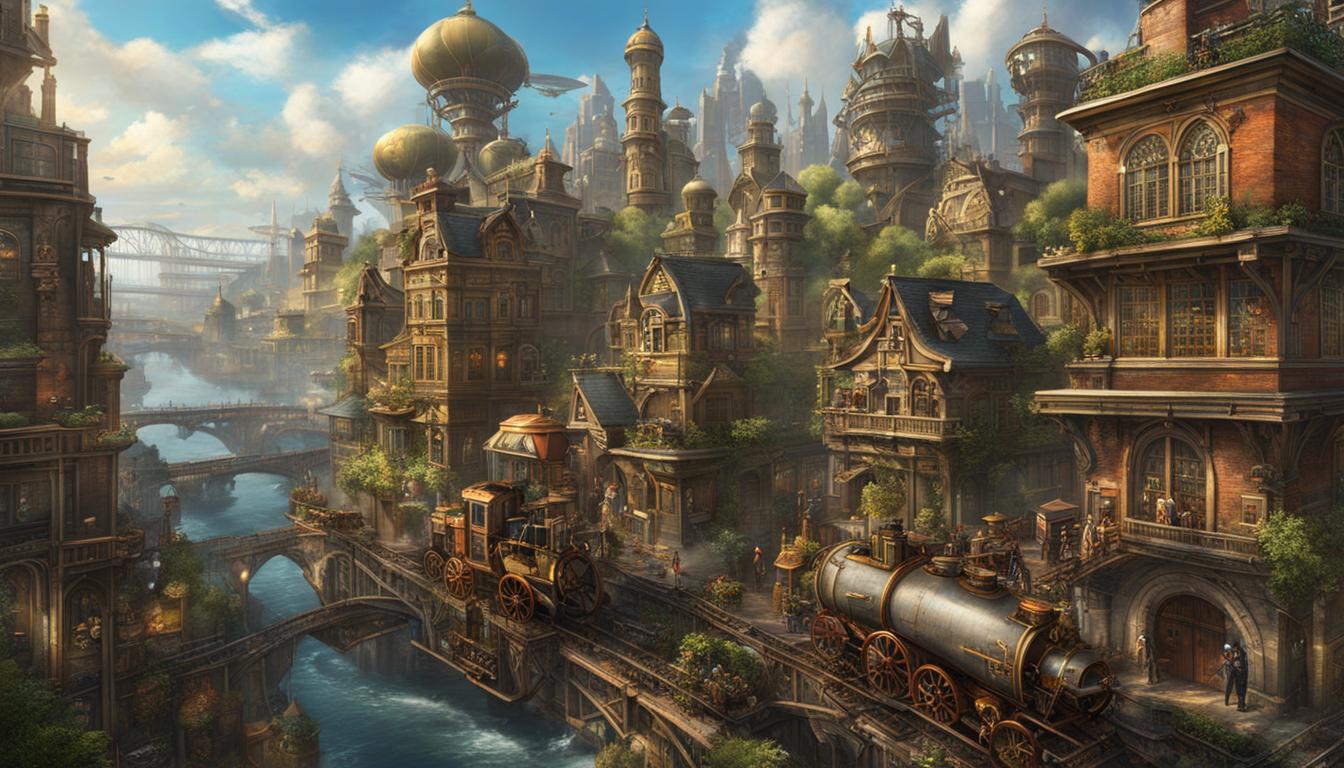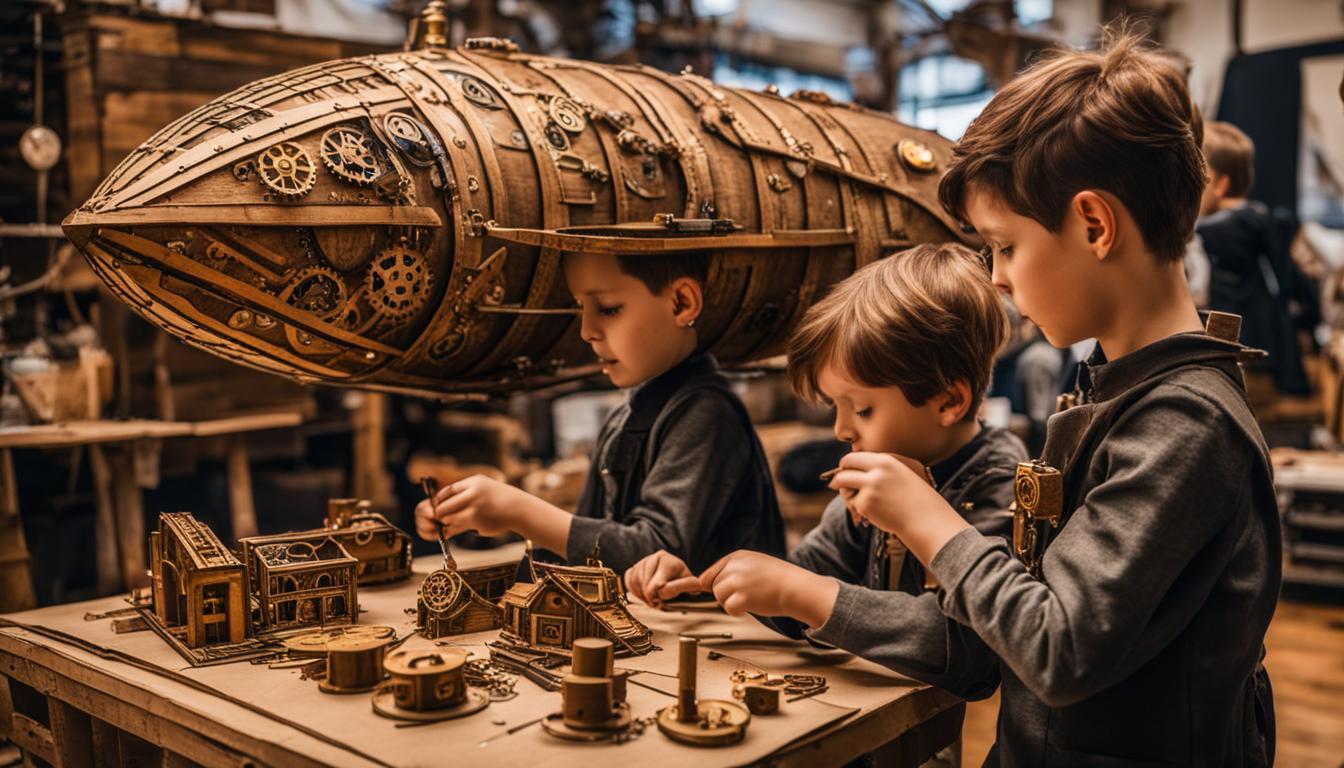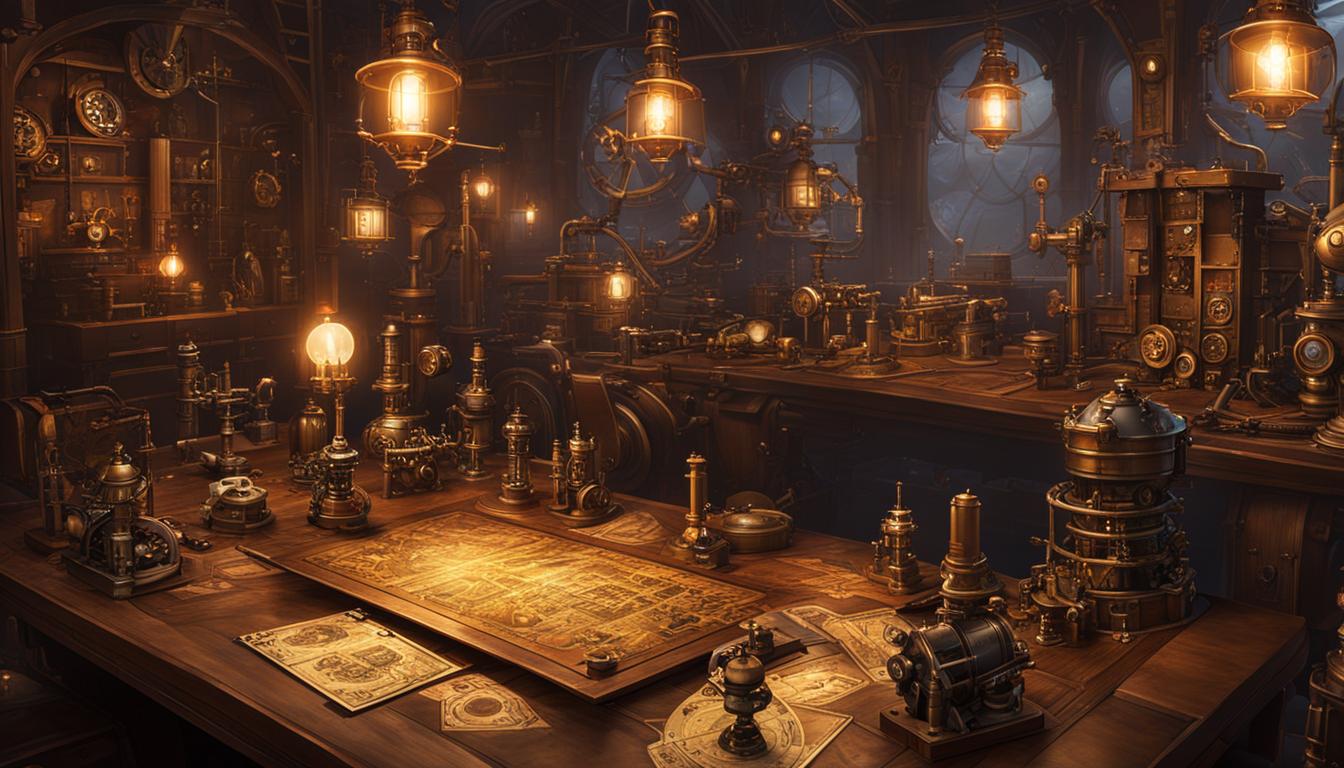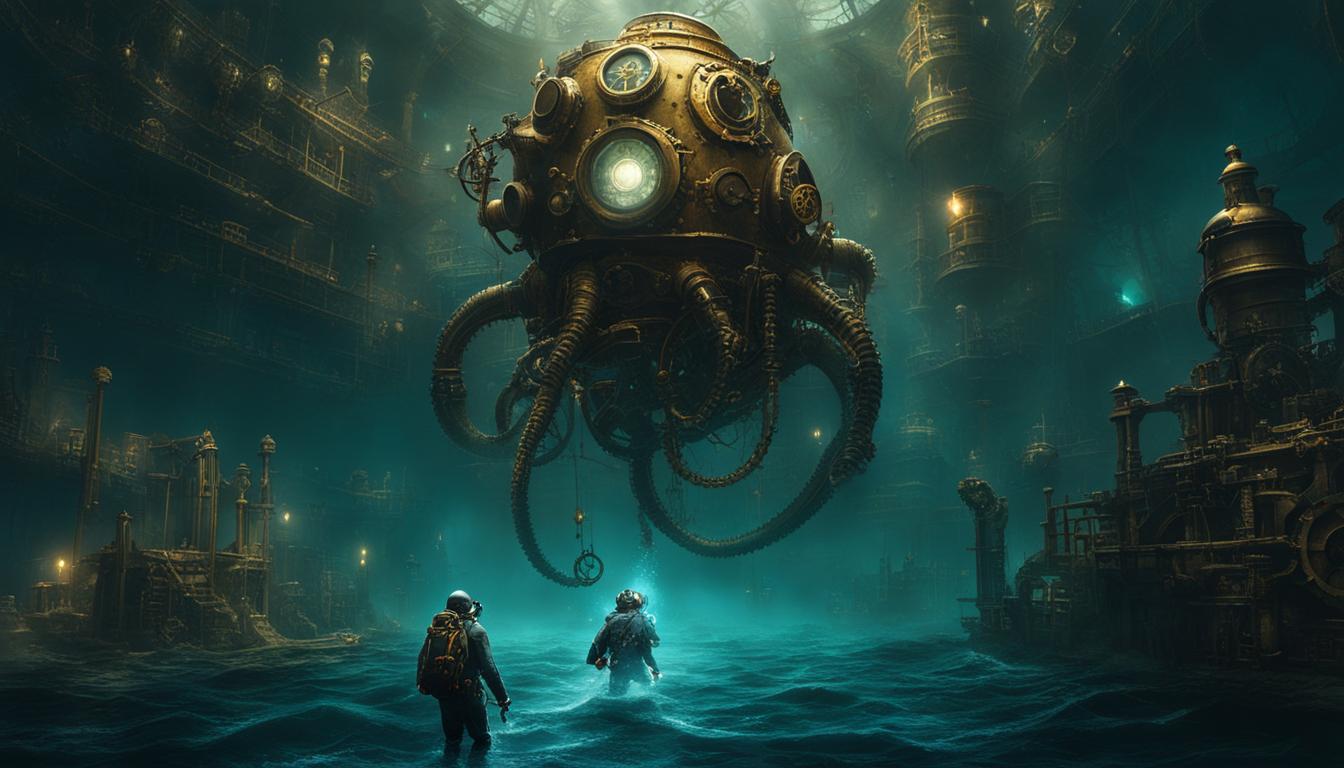Steampunk, the captivating subgenre of science fiction, breathes life into a world where retrofuturistic technology meets the aesthetics of 19th-century steam-powered machinery. Mirroring an alternative history of the Victorian era or the American “Wild West,” steampunk relies on the enduring power of steam. However, to truly immerse oneself in the enchanting realm of steampunk, it is essential to craft a rich lore and weave captivating myths.
The allure lies in the delicate balance between technology and magic, both of which play significant roles in the lives of steampunk characters. By seamlessly blending these elements, a unique and intriguing mythology unfolds, captivating readers and viewers alike. Journey through the intricacies of steampunk lore creation and discover the mysteries that lie within this captivating world.
Key Takeaways:
- Steampunk combines retrofuturistic technology with 19th-century steam-powered aesthetics.
- Crafting a compelling steampunk world requires the development of a rich lore and captivating mythology.
- Technology and magic coexist in steampunk, with both playing significant roles in the everyday lives of characters.
- The balance between technology and magic is crucial in creating a captivating steampunk mythology.
- By carefully crafting myths and legends, the steampunk lore becomes an integral part of the narrative and enhances the storytelling experience.
Integrating Myths and Legends into Steampunk Settings
In the exciting world of steampunk, storytelling takes on a whole new dimension as myths and legends intertwine with the fantastical technology of the genre. By developing steampunk mythological tales, creators have the opportunity to weave captivating narratives that transport readers and viewers to imaginative realms.
Building mythology within steampunk narratives involves harnessing the themes and motifs of the genre. The tension between technological advancements and societal norms becomes a fertile ground for crafting captivating legends. From the origins of specific technologies to the rise and fall of empires, these myths add depth and richness to steampunk worlds.
“Steampunk mythology allows us to explore the intricate relationship between technology and society, offering insights into the consequences of progress and the limitations of our own imagination.”
Storytelling is a crucial element in steampunk mythology, as it draws audiences into the world and enables them to engage with the characters and their struggles. Through carefully crafted myths and legends, the lore of the steampunk universe becomes an integral part of the narrative, immersing the audience in a mesmerizing experience.
To get a taste of the diverse mythological tales that can be found in steampunk settings, let’s explore a few examples:
The Legend of the Clockwork Guardians
In a steampunk world on the brink of chaos, a group of mechanical beings known as the Clockwork Guardians emerges. Created to maintain order and protect society, they are revered as living legends. But as the story unfolds, the true origin and purpose of these guardians is revealed, challenging the beliefs of the protagonists and pushing the boundaries of their understanding.
The Steam Phoenix’s Ascension
Deep within the heart of a steampunk city lies an ancient legend of a creature called the Steam Phoenix. This majestic being possesses the power to harness steam and transform it into a force of both destruction and creation. As the city faces imminent disaster, a young inventor embarks on a perilous journey to awaken the dormant powers of the Steam Phoenix and save their world from destruction.
With such immersive storytelling, it’s no wonder that the steampunk genre continues to captivate audiences, transporting them to imaginative worlds where technology and mythology coexist in perfect harmony.
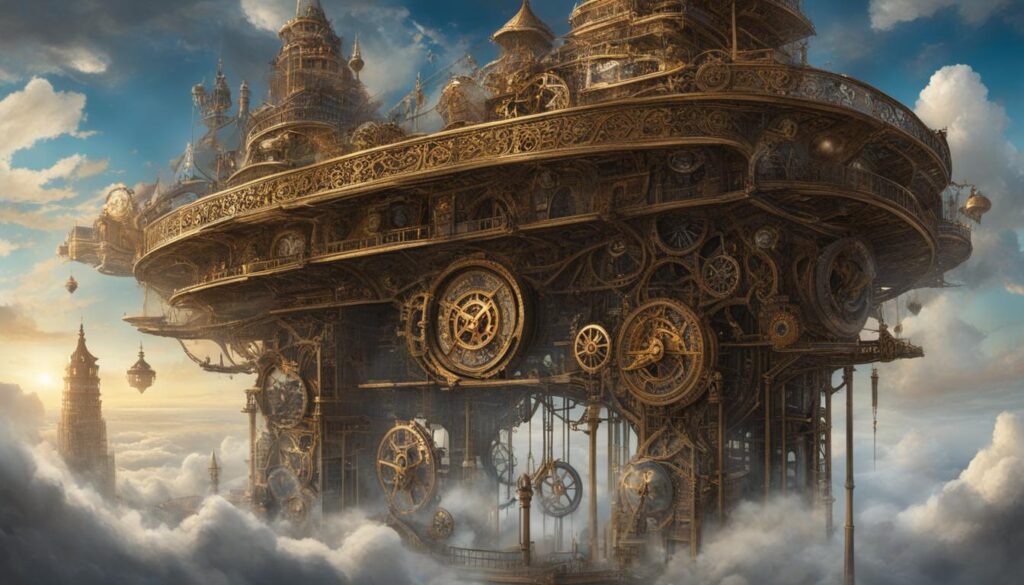
Table: Examples of Steampunk Mythological Tales
| Mythological Tale | Description |
|---|---|
| The Enigma of the Ether Engines | Ancient tales speak of the Ether Engines, mysterious devices that tap into the ethereal realms and power the steampunk world. As an apprentice engineer uncovers the secrets behind these engines, he becomes entangled in a web of intrigue and conspiracy. |
| The Mech-Mage’s Regret | In a society where magic and machinery clash, a renowned Mech-Mage is haunted by a tragic event from his past. As he delves into his memories and confronts the mistakes he made, he discovers the true power of redemption and the importance of balancing technology and magic. |
| The Forgotten Clockwork Forest | Deep within the heart of a sprawling metropolis, a hidden forest of clockwork trees holds the key to unlocking the steampunk world’s greatest secret. A courageous explorer ventures into the enchanting forest, only to discover that the fate of their entire civilization rests in their hands. |
These examples are just a glimpse into the vast world of steampunk mythology. By delving into the depths of imagination and merging it with the essence of the genre, creators can craft legendary tales that leave audiences spellbound.
Balancing Technology and Magic in Steampunk Lore
Steampunk lore is a fascinating blend of technology and magic, creating a unique and immersive world for readers and viewers to explore. Crafting this balance requires careful consideration of the role each element plays in the society and how they interact with one another. By developing a solid foundation for the coexistence of technology and magic, creators can build a rich mythology that enhances the storytelling experience.
One technique for steampunk mythology creation is to explore the limitations and abilities of both technology and magic. This allows for a deeper understanding of how they shape the world and impact the lives of the characters. For example, technology may provide the means for advanced transportation or communication, while magic could be harnessed for healing or protection. Understanding the capabilities and boundaries of each element allows for organic integration into the lore.
“The interplay between technology and magic in the steampunk world is truly captivating. It creates a sense of wonder and intrigue, as characters navigate a society where clockwork machines coexist with mystical forces,” says renowned steampunk author, Emily Sinclair.
In addition to exploring the capabilities of technology and magic, lore development in steampunk stories can also involve the creation of unique magical systems and the inclusion of magical creatures or races. This further enriches the mythology by introducing elements that are specific to the steampunk world. For example, mythical creatures such as steam dragons or clockwork fairies can add depth and wonder to the narrative.
| Steampunk Mythology Creation Techniques | Lore Development in Steampunk Stories | Crafting Legendary Tales in Steampunk |
|---|---|---|
| Explore the limitations and abilities of technology and magic | Create unique magical systems | Introduce magical creatures or races |
| Consider the social and cultural implications of technology and magic | Showcase the interplay between technology and magic | Examine the consequences of relying too heavily on either element |
| Strike a balance between technology and magic | Integrate technology and magic into everyday life | Develop a cohesive and immersive steampunk world |
By striking a balance between technology and magic, integrating them into everyday life, and exploring the consequences of relying too heavily on either element, steampunk creators can craft legendary tales that captivate audiences and transport them to a world unlike any other.
Conclusion
Steampunk legends and lore have the power to transport readers and viewers into a world where technology and magic collide. By crafting captivating steampunk folklore, creators can enhance the storytelling experience and immerse audiences in a realm of wonder and intrigue.
Through careful balance, the integration of myths and legends into steampunk settings adds depth and richness to the narrative. By exploring the tensions between technological advancements and societal norms, these stories become more than just tales; they become reflections of our own struggles and aspirations.
Steampunk lore development is not limited to gods and mythical creatures alone. It encompasses the intricate relationship between technology and magic, delving into the consequences of their use and the cultural implications they bring. This exploration allows for the creation of legendary tales that captivate the imagination and leave a lasting impression.
So, embrace the allure of steampunk and let your creativity soar. Craft steampunk folklore that will transport readers and viewers into a realm where the possibilities are endless. Whether it’s through the creation of new gods or the exploration of the intricate balance between technology and magic, let the world of steampunk legends and lore captivate you.
FAQ
What is steampunk?
Steampunk is a subgenre of science fiction that combines retrofuturistic technology with aesthetics inspired by 19th-century industrial steam-powered machinery.
What is the purpose of developing lore and mythology in steampunk?
Developing rich lore and mythology adds depth and richness to the steampunk world, creating a compelling storytelling experience.
How can I integrate myths and legends into steampunk settings?
To integrate myths and legends, consider the themes and motifs of the steampunk genre and create stories about the origins of technologies, rise and fall of empires, and struggles between different factions within the steampunk society.
How do technology and magic interact in steampunk worlds?
Technology and magic coexist in steampunk worlds, and finding a balance between the two is important. Explore their limitations, abilities, and social implications in order to create an engaging mythology.
What challenges are involved in creating steampunk lore?
One challenge is finding the right balance between technology and magic. Careful consideration of their interaction and coexistence is necessary to develop a captivating mythology.

